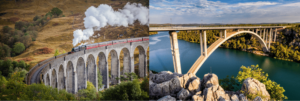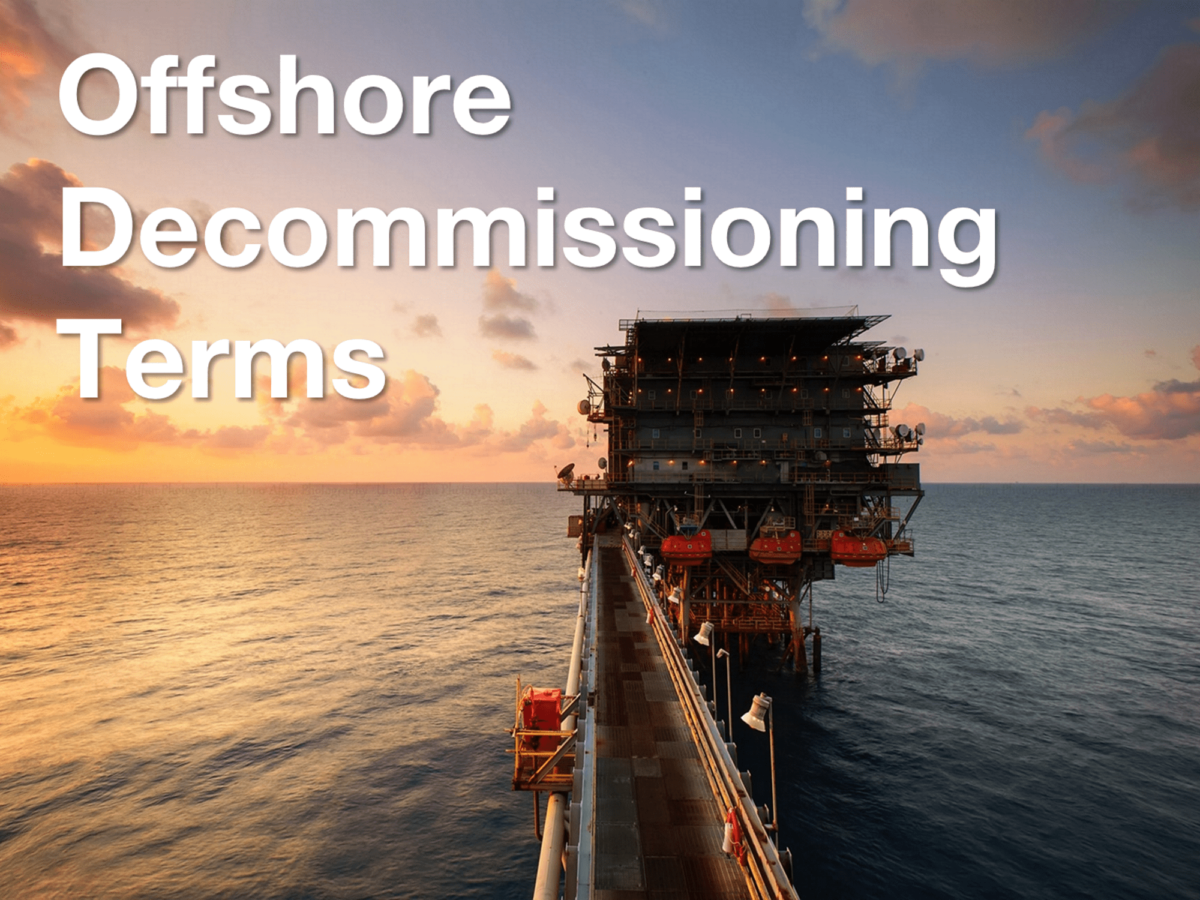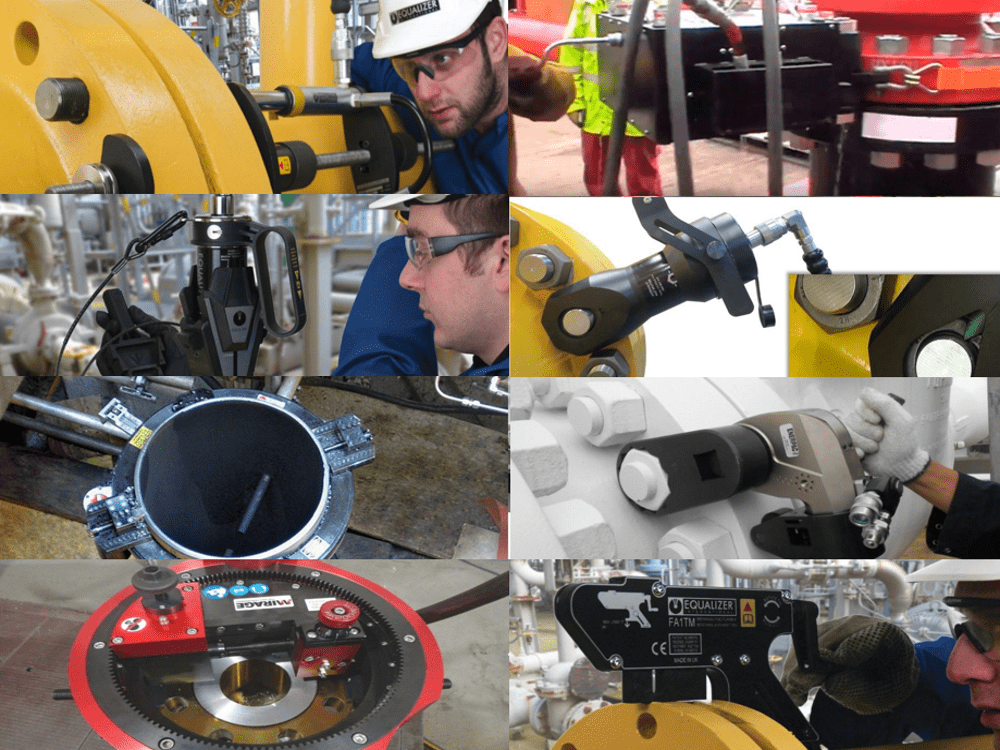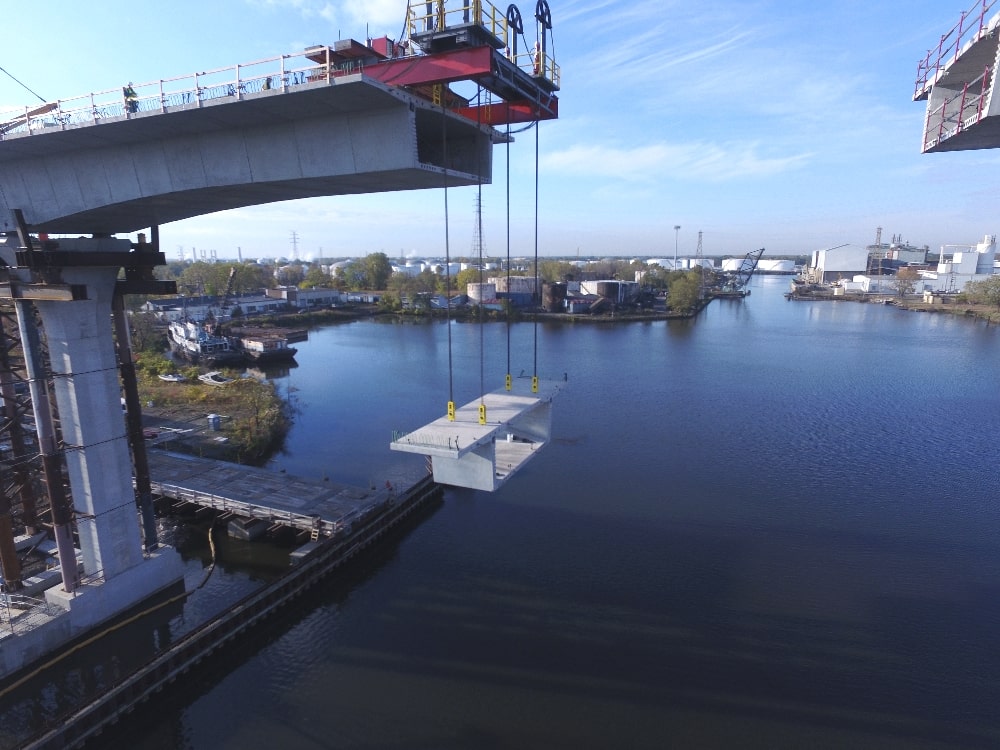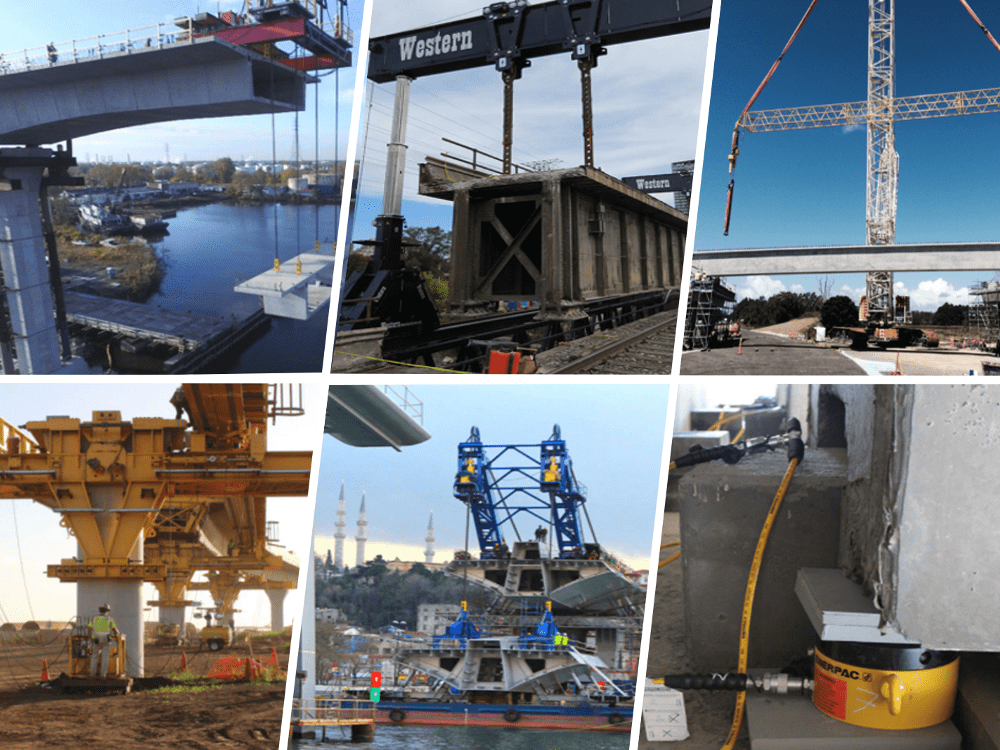Bridge Terminology: A to Z Glossary for Engineers

January 3, 2023
0
Bridge terminology can seem bewildering to anyone new to the sector. Like most industries, bridge construction and maintenance can be complex and highly technical – so there are plenty of terms and phrases to familiarize yourself with.
That’s why we’ve put together a glossary of bridge terms in a handy A to Z format. So if you plan to work on bridge construction and maintenance projects in the near future, browse through the listings below, or bookmark this webpage for when you hear a term you don’t understand.
Bridge Terminology Glossary
B
Back-stay
A rope or cable extending backward from the head of a mast and fastened to some permanent object. E.g. as in a suspension bridge.
Bar Cutter
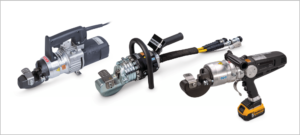
A hydraulic machine to cut metallic bars such as rebar into shorter lengths. More about Bar Cutters
Barge
A flat-bottomed boat having the capacity to heavy loads when erecting spans by flotation.
Bascule Bridge
A bridge with a span that opens by rotating vertically.
Bateau Bridge
A pontoon bridge, floating and supported by boats or barges.
Batter Pile or Battered Pile
A pile driven at an angle.
Battered Pier
A tapered pier with slightly angled sides. Larger at the base than at the top.
Beam Span
A span built with beams.

Above: a beam bridge
Bearing
The shoes supporting a span. Case study
Bearing Pile
Any pile carrying a vertical load.
Bedrock
Solid rock beneath sand or silt.
Bent
Supporting frame including posts or piles with bracing, caps, and sills.
Bottom Chord
The lower member of a truss.
Bowstring Truss
A truss in which the lower chord is horizontal and the upper chord joints lie in the arc.
Breast Wall
A retaining wall built to sustain a lateral pressure, e.g. earth thrust
Bridge-seat
The part at the top of a bridge pier or abutment that receives the pedestals or shoes of the superstructure.
C
Cable
A heavy twisted wire rope suspending sections of a suspension bridge.
Cable-Stayed Bridge

Uses deck cables connected to one or more vertical towers, or pylons in either a fan or harp configuration
Caisson
A watertight box or casing used in founding and building structures in water too deep for cofferdams.
Camber
A positive, upward curve (deformation) built into a beam due to prestressing.
Cantilever Bridge

A structure with at least one portion of which acts as an anchorage for sustaining another portion projecting beyond the supporting pier.
Cast-in-Place Concrete
Poured site to create a structural element in its final position.
Catenary Curve
The curve of a rope or chain hanging freely between two towers.
Chain Bridge
A suspension bridge using chains instead of cables.
Channel Span
The bridge span over the deepest part of a river most accessible for river traffic.
Cofferdam
An enclosure built within a body of water to allow the enclosed area to be pumped out.
Combination Bridge
A bridge constructed of timbers and steel or iron.
Composite Beam
A steel beam with concrete decking above.
Condition Ratings
National Bridge Inspection Standards (NBIS), condition ratings to describe condition compared to if it were new.
Continuous Beam A beam resting on three or more supports.
Continuous Truss
A truss extending over three or more supports.
Controlled Lifting Pump
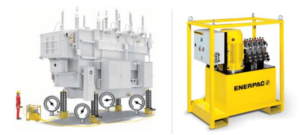
A hydraulic pump used for synchronous lifting with hydraulic cylinders
Corbel
A small shelf cantilevered out from a beam, wall, or column in order to support a beam or a other load. Sometimes called a tassel or bragger.
Counterweight
A counterweight used on lift bridges, draw bridges, or bascule bridges to stabilizes and provide balance for the bridge lift system.
Crescent Truss
A truss with both chords curved upward, or both downward making sharp intersections with each other at the ends. The outline resembles a crescent,
Cribbing
Timbers piled cross-wise to form a support for a load.
Culvert
A drain, pipe or channel for water to pass under a road, railroad or embankment.
Cutwater
Also known as a starling. The projecting ends of a bridge pier. Shaped as to allow water, ice, or other items to strike without damaging the structure.
Cylinder Pier
A pier made of a cylindrical steel shell filled with concrete.
D
Deck Bridge
A bridge in which the passing loads are carried directly to the upper portions of the posts.
Diversion Channel
A bypass to divert water around a structure to allow construction to take place.
Division Wall
A partition wall that carries no load.
Draw Bridge
A bridge that may be turned to one side, or lifted up, either wholly or in sections, to let boats pass under it.
Dumb-bell Pier
A pier with two cylindrical piers connected by a solid web.
E
Earth Pressure
The lateral pressure exerted by a bank of earth when supported by a retaining wall or an abutment.
Elastomeric Bridge Bearing
A bearing type commonly used on modern bridges. Designed to compress under a vertical load, while allowing for horizontal rotation and lateral shear movement.
Emerson's Foundation Pump
A pump adapted for pumping water out cofferdams to allow work to take place.
Euler's Formula
A formula expressing the resistance of long columns to buckling.
Expansion Bearing
A support at the end of a span to allow expansion and contraction of the bridge.
Expansion Rollers
A group of steel cylinders in a box or suitable frame beneath the shoe of a bridge span to allow for movement during temperature changes and loading.
F
Falsework
The scaffold or temporary supports used when erecting a structure..
Fender Pile
A pile used at wharfs, or in front important structures to protect them from sudden blows by vessels.
Floating Pier
A pier sunk to a great depth in a soft, or semi-fluid soil relying on the principle of flotation for stability.
Formwork
A support system for freshly poured concrete - including the mold and all supporting bracing/ components.
Foundation Pit
An excavation in which a foundation is placed.
G
Gabions
Baskets of galvanized steel wire holding rocks together to reduce erosion of embankments.
Gilbreth Pile
A corrugated reinforced concrete pile.
Girder Bridge
A bridge constructed from lattice girders.
Gray Column
A structural steel column composed of eight angle-irons riveted together in pairs.
Gusset Plate
A metal plate used to connect the structural members of a truss.
H
Haunch
The enlarged part of a beam near its supported ends.
Head Wall
The wall at the head or main part of an abutment.
Hicky
A slang expression used by bridge workers for almost any item for example when it lacks a specific name. e.g. thingumbob, thingamajig.
Hutton's Formula
A formula to calculate wind-pressure on surfaces facing the wind.
Hydraulic Gantry
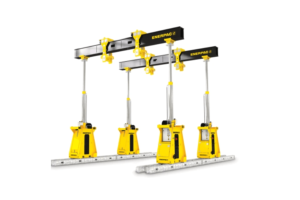
Used to lift and position heavy loads from above in here traditional cranes will not fit. See more
Hydraulic Jack
A device for lifting heavy weights or exerting great force by means of liquid pressure.
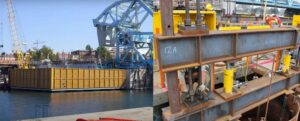
Used in groups to lift heavy loads such as bridge decks for bearing maintenance. Also known informally as a ram or jack.
Hydraulic Pump
Used to supply hydraulic flow (oil) to activate hydraulic lifting equipment.
I
I-Beam
A rolled structural shape with a cross-section shaped like the letter "I."
Impost
The point where an arch rests on a wall or column, or the upper part of a pier from which an arch springs.
J
Jack Up System
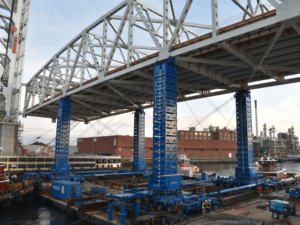
A multi-point lifting system, typically includes four jack-up units positioned under each corner of a load.
Jersey Barrier
A low, reinforced concrete wall wider at the base, tapering vertically to near mid-height, then continuing straight up to its top.
Jib Crane
A crane having a swinging boom.
K
Key Pile
The main pile in a group of piles.
L
Lattice Truss
A truss having several web systems
Leading Beam
A beam placed as a guide for other beams.
Leg Bridge
A bridge resting on legs instead of masonry abutments.
Lift Bridge
A type of movable bridge that travels in a vertical plane. Also known as a hoist bridge.
Limit Load
The greatest load a structure is allowed to carry as stated in the specifications. A safety load.
M
Metal Lath
A perforated metal sheet for reinforcing concrete.
Monier-Construction
A form of reinforced concrete using wire netting.
Movable Cofferdam
A cofferdam constructed of timber, hinged at one corner and joined on the diagonal corner so it can be opened after the pier is built and moved away to another pier site.
N
Nest (of rollers)
A group of rollers, arranged in a frame or box to support a bridge shoe.
Nosing
The end of a pier. See also "Starling." The projecting end of a bridge-pier, shaped to allow ice, drift, etc., to strike it without injury.
O
Oblique Arch
An arch in which the axis is not perpendicular to the central plane of the structure.
Open-dredging
A process of sinking piers by excavating with a dredge through an open crib.
Outrigger
A beam or joist projecting from a structure. Used to support a load at its end.
P
Parabolic Truss
A bow-string truss with the upper chord joints in a parabola.
Parapet or Parapet Wall
A low wall or barrier placed on top of an abutment to stop the earth from encroaching on the end of the span.
PBES
Prefabricated Bridge Elements and Systems
Pedestal
A footing for a tower post. A bridge shoe.
Pedestal Block
A steel or iron casting upon which the bridge-shoe rests. Also a stone block to support a column.
Pedestal Cap
A block of stone or concrete placed on top of a footing to carry a loaded column.
Pedestal Pile
A pile formed by driving a steel shell into the ground, putting in small quantities of concrete, and hammering down to force the concrete into the earth beyond the point of the shell, therefore increasing the bearing area.
Pedestal Strut
A strut connecting and bracing two pedestals.
Permanent Load
Same as "Dead Load." The weight of all the parts of a bridge.
Pile
A vertical support structure used to hold up a bridge. Typically made of wood, concrete, or steel.
Pier
Also called ‘bent’. Typically bents with one column are called piers. Used to transmit the loads from a bridge superstructure to the foundation.
Pile Driver
A machine for sinking or driving piles.
Pile Foundation
A foundation formed in soft soil by driving a group of piles to a depth to give the required bearing capacity to carry the load.
Pivot Pier
The pier supporting a bridge’s swing span upon which it turns.
Post-tensioning
Application of tensile forces to the steel tendons after the segments are in place. These forces allow the span to carry the desired loads.
Pre-Cast Girder
A girder fabricated off-site from cement that uses reinforced steel and post-tensioning cables.
Prestressed Concrete
A type of pre-cast concrete girder in which compressive stresses are introduced in a fabrication facility. These allow the member to carry larger loads than conventional reinforcement.
Primary Truss
The main truss that supports smaller trusses.
Pylon
A vertical structure marking the entrance to a bridge.
Q
Quiescent Load
A load that is not in motion.
R
Ram
The hammer of a pile driver. Also another name for a hydraulic cylinder.
Refuge-bays
Platforms built on the side of a trestle or bridge so that personnel can get out of the way of approaching trains.
Reinforced Concrete
Concrete in which steel bars are inserted to strengthen it.
Reinforcing Bar
'Rebar' - A bar or rod placed in concrete constructions to increase their resistance, especially to bending and shear.
Revet
The process of covering an embankment with stones.
Rib
An extra and external portion of a body giving it additional strength and stiffness
Rocker Bearing
A bridge support that accommodates expansion and contraction of the superstructure through a rocking action.
Roller Bearing
A single roller or a group of rollers to allow longitudinal movement/expansion of a structure.
Roller Box
An iron or steel box holding rollers for a bridge shoe.
S
Salient
A portion projecting beyond the general line of the structure.
Sand Bearing
A temporary bearing made with confined sand for lowering the object that is temporarily supported. The sand is released to lower the load.
Secondary Member
Generally refers to sub-diagonals and suspenders of trusses
Semi-cantilevering
A way to erect a span without falsework by cantilevering from adjacent spans
Sheave
A wheel with a grooved face for carrying a rope or cable.
Sheet Pile
A form of piling used to shut out water. Made of planks spiked or bolted together in a tongued and grooved effect.
Shoefly
A temporary bridge taking the place of the main bridge while construction is completed on the main bridge.
Shoe Pin
The pin in a shoe which receives the load from a span or a column.
Short Ton
A ton of two thousand pounds. (in the US). 907.19 kg
Simple Beam
A beam with its ends free and resting on two supports.
Skew Bridge
A bridge where the spans are not perpendicular to the piers, abutments, road, or river beneath.
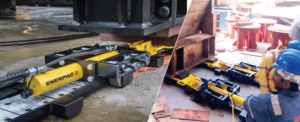
A system using hydraulic push-pull cylinders, traveling over a pre-constructed track.
Slab Bridges
The most common type of bridge. Used in where the span does not need to be long.
Span
The distance between two supports holding up a structure.
Spandrel
The roughly triangular piece formed by an arch.
SMPT
Self-Propelled Modular Transporter used to move sections of a bridge into position
Starling
A ‘cutwater’, the projecting end of a bridge-pier, shaped to allow ice, drift, etc to strike it without damage to the structure.
Stanchion
One of the larger vertical posts supporting a railing.
Static Load
Same as "Dead Load." The weight of all the parts of a bridge.
Stiffened Suspension Bridge
A suspension bridge with stiffening trusses.
Strand Jack
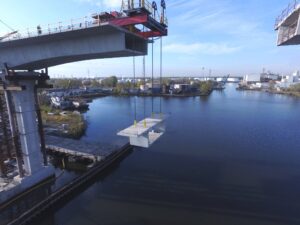
Lifting equipment that includes a bundle of steel cables guided through a hydraulic cylinder.
Substructure
Consists of all of the parts that support the superstructure such as the abutments, piers, footings, and piling.
Superstructure
The portion of a bridge above the piers, pedestals, and abutments. The part of a structure which receives the live load directly.
Suspension Bridge

A roadway suspended from chain or wire cables. Usually hung between huge towers and securely attached to abutments.
Suspenders
Tension members of a suspension bridge hanging from the main cable to support the deck.
Synchronous Hoist System
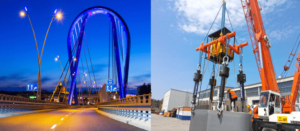
A below-the-hook sling adjuster used with cranes for accurate positioning.
T
T-Beam
A reinforced concrete beam or a rolled structural shape with a cross-section like a letter "T."
Tendon
Steel strands used for post-tensioning.
Tension
The state or condition of a component being stretched.
Test Pile
A pile in place loaded with a known weight for testing the bearing capacity of the soil.
Tied-arch Bridge
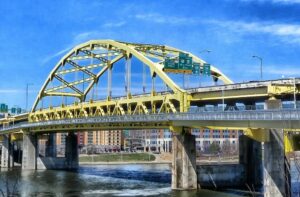
A 'bowstring bridge' using features seen in both a suspension bridge and an arched bridge.
Top Chord
The upper member of a truss, usually resisting compression.
Torque
The moment of a force or a system of forces tending to produce rotation.
Trestle Bridge
A bridge composed of bents or towers carrying the deck. Can be either timber or metal.
Truss Bridge
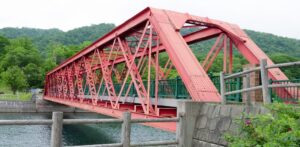
A very strong type of bridge constructed with metal girders.
Tubular Arch Bridge
A bridge in which the primary supporting members are arched tubes.
U
U-Abutment
A straight abutment with additions of two wing walls at right angles to the face.
Under Crossing
A crossing where one of the roads or tracks is below the other.
Uplift
The unwanted tendency of a structure to rise from its supports due to special loading conditions
Uplift Stress
Stress due to an uplift action, as that from the end lifting machinery in a swing span.
V
Vertical Lift Bridge
A bridge having a span that hoists vertically.
Viaduct
An extended bridge of many spans, mainly over dry ground.
Vertex
The highest point, crown, or apex.
W
Washout
The destruction or displacement of a bridge or embankment due to floods.
Water Cement
A cement that sets or hardens under water.
Ways, or Launching Ways
Supports or tracks set on a slope, down which a caisson slides at the time of launching.
Wearing Surface
The top layer of material on a roadway
Wind Bracing
Bracing, taking up the stresses caused by the wind.
Wing Abutment
An abutment similar to a U-abutment except that the two wings make angles with the face of from thirty to forty-five degrees.
Wing Wall
One of the side walls of an abutment extending outward from the head wall to hold back the slope of an embankment.
Working Pit
The excavation for a foundation.
X, Y, Z
X-Bracing
Any system of bracing in which the diagonals intersect.
Yield Point
The point, or intensity of stress, at which the rate of stretch begins to increase rapidly.
Sources
